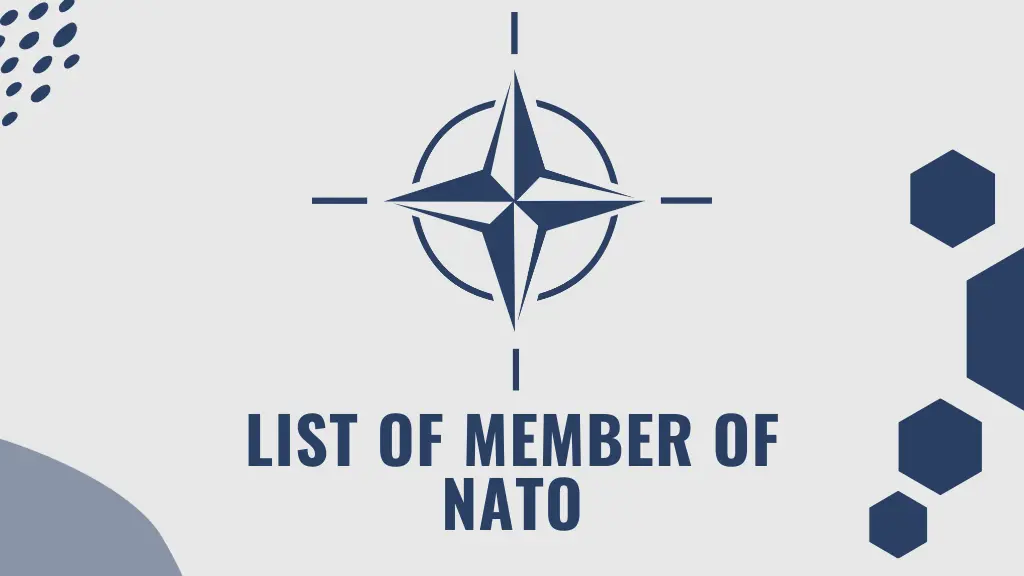In a rapidly changing world, international alliances play a pivotal role in maintaining peace and security. One of the most influential and enduring alliances is the North Atlantic Treaty Organization, better known as NATO. Since its creation in 1949, NATO has been a cornerstone of collective defense, bringing together countries from North America and Europe under a shared commitment to safeguard freedom and stability.
This article provides a detailed explanation of the list of members of NATO, exploring both founding members and countries that joined later, along with their contributions, roles, and strategic importance. By tracing NATO’s evolution, we gain a deeper understanding of how international cooperation continues to shape global security.
A Comprehensive List of Members of NATO
The NATO alliance began with twelve founding members but has expanded significantly over the decades. Each new member brought with it unique strategic advantages and commitments to collective defense. Today, NATO represents not only a military alliance but also a symbol of unity, democratic values, and shared security interests.
Founding Members
NATO was officially established on April 4, 1949, with the signing of the North Atlantic Treaty in Washington, D.C. The original twelve nations that came together to form the alliance laid the groundwork for one of the most enduring institutions of modern history.
United States of America
The United States was among the twelve original members of NATO and remains the backbone of the alliance. Its military strength, economic capacity, and leadership have ensured NATO’s effectiveness for more than seventy years. The U.S. has consistently played a central role in shaping alliance policy, funding military operations, and ensuring that Article 5 the collective defense clause remains credible.
Canada
Canada has been a steadfast NATO member since 1949. Though smaller in population compared to other founding members, Canada has consistently contributed military forces, peacekeeping expertise, and diplomatic leadership. Its role in NATO demonstrates how mid-sized powers can influence global security frameworks through multilateral cooperation.
United Kingdom
The United Kingdom’s membership in NATO reflects its historic role as a transatlantic bridge between Europe and North America. As one of the alliance’s leading military powers, the UK has contributed significantly to NATO operations, intelligence sharing, and strategic planning. Its nuclear deterrent adds to NATO’s overall security posture.
France
France was a founding member of NATO, and although it withdrew from the alliance’s integrated military command structure in 1966 to pursue greater independence, it remained politically committed to NATO’s mission. In 2009, France reintegrated fully, reaffirming its dedication to the alliance. Its strong military, global presence, and diplomatic influence make it a crucial partner.
Belgium
Belgium, a small yet strategically significant nation, was one of the original twelve signatories of the North Atlantic Treaty. It hosts key NATO institutions, including NATO’s headquarters in Brussels, symbolizing its central role in coordinating alliance policy and operations.
Netherlands
The Netherlands has consistently played an active role in NATO’s operations and policymaking. Its strong economy, advanced military technology, and diplomatic influence have enabled it to contribute effectively to collective defense, humanitarian missions, and crisis management.
Luxembourg
Though small in size, Luxembourg has consistently shown its commitment to NATO’s mission. Its participation reflects the principle that collective defense does not depend solely on military might but also on shared political will and cooperation.
Norway
As one of NATO’s founding members, Norway strengthened the alliance’s northern defense line. Its strategic location in the Arctic and North Atlantic continues to play a critical role in NATO’s ability to monitor and secure vital sea routes and northern airspace.
Denmark
Denmark’s membership has bolstered NATO’s northern European security posture. With access to the Baltic Sea and the Arctic, Denmark is strategically vital for NATO’s defense planning, while its active participation in international missions demonstrates its ongoing commitment.
Iceland
Despite not maintaining its own standing army, Iceland joined NATO in 1949. Its geographic location in the North Atlantic provides a crucial strategic advantage for monitoring maritime routes and airspace. Iceland’s inclusion illustrates NATO’s broad approach to collective defense, even for nations without conventional armed forces.
Portugal
Portugal, located on Europe’s southwestern edge, has been an active NATO member since the beginning. Its access to the Atlantic Ocean, historical ties with the Americas, and experience in overseas operations have made it a valuable contributor to NATO’s maritime security.
Italy
Italy’s location in southern Europe gives it immense strategic importance within NATO. As a founding member, Italy has consistently supported alliance operations, hosting bases, and contributing forces to peacekeeping, crisis response, and defense missions.
Members Who Joined Later
After its creation, NATO gradually expanded to include new nations, especially after the end of the Cold War. These additions strengthened NATO’s ability to address global threats and ensured the alliance adapted to changing geopolitical realities.
Greece (Joined in 1952)
Greece brought significant military capability and strategic depth to NATO’s southern flank. Its geographic location near the Mediterranean has made it central to maritime and regional security operations.
Turkey (Joined in 1952)
Turkey’s membership expanded NATO’s reach into the Middle East and Asia. Its unique position at the crossroads of Europe and Asia has allowed NATO to project influence in multiple regions while ensuring a strong southeastern defense line.
Germany (Joined in 1955)
Germany’s entry into NATO marked a turning point in European security. Following World War II, its membership symbolized reconciliation and integration. Today, Germany remains one of NATO’s most influential members, providing economic power and military capability.
Spain (Joined in 1982)
Spain’s democratic transition in the late 20th century paved the way for NATO membership. Since joining, Spain has actively participated in NATO operations and contributed naval and air power to alliance missions.
Poland (Joined in 1999)
Poland’s entry into NATO in 1999 was a major step in strengthening the alliance’s eastern defense. As the largest new member at the time, Poland brought strong military capabilities and a strategic position near Russia. Since then, it has hosted NATO troops and actively participated in missions, proving its commitment to collective security.
Czech Republic (Joined in 1999)
The Czech Republic joined NATO in 1999, reinforcing the alliance’s presence in Central Europe. Its membership symbolized a successful transition from Soviet influence to Western security structures. The country has supported NATO missions in Afghanistan and the Balkans, reflecting its dedication to alliance values.
Hungary (Joined in 1999)
Hungary’s NATO membership in 1999 anchored it firmly within Euro-Atlantic security. Its location in Central Europe makes it strategically important, while its participation in peacekeeping missions demonstrates its commitment to the alliance.
Slovakia (Joined in 2004)
Slovakia’s accession to NATO in 2004 strengthened the alliance’s position in Central Europe. Having transitioned from a post-communist state to a democratic republic, Slovakia’s membership symbolized its commitment to Euro-Atlantic integration. Its contributions to NATO missions, particularly in Afghanistan and Kosovo, highlight its dedication to collective defense and international stability.
Slovenia (Joined in 2004)
Slovenia, located at the crossroads of Central and Southeastern Europe, brought important strategic depth to NATO upon joining in 2004. Despite its relatively small size, Slovenia has consistently participated in NATO operations and supported alliance initiatives, reflecting its commitment to security and peace within Europe.
Estonia (Joined in 2004)
Estonia’s membership in 2004 marked a historic moment for the Baltic region. Sharing a border with Russia, Estonia plays a vital role in NATO’s eastern defense posture. The country has invested heavily in modernizing its defense forces and is known for its expertise in cyber defense, making it a valuable contributor to NATO’s evolving security priorities.
Latvia (Joined in 2004)
Latvia’s entry into NATO, along with its Baltic neighbors, ensured greater security for the region. Its location on the Baltic Sea makes it strategically important, particularly in safeguarding maritime and airspace security. Latvia has actively hosted NATO exercises and troops under the alliance’s Enhanced Forward Presence, underscoring its role in deterring potential threats.
Lithuania (Joined in 2004)
Lithuania joined NATO in 2004 with a strong commitment to Euro-Atlantic security. Its geographic position, bordering both the Baltic Sea and the Russian exclave of Kaliningrad, makes it a critical component of NATO’s defense strategy in the region. Lithuania has been a vocal advocate for a strong NATO presence in Eastern Europe and consistently contributes to joint missions.
Bulgaria (Joined in 2004)
Bulgaria’s accession to NATO expanded the alliance’s influence in Southeastern Europe and the Black Sea region. The country’s strategic location provides NATO with critical access points for operations and monitoring regional security dynamics. Bulgaria has actively participated in international missions, demonstrating its dedication to collective defense.
Romania (Joined in 2004)
Romania’s NATO membership significantly reinforced the alliance’s presence in Eastern and Southeastern Europe. Its strategic location along the Black Sea and its commitment to modernization of its armed forces have made it an important NATO partner. Romania has hosted multinational exercises and contributed to peacekeeping operations, strengthening the alliance’s regional posture.
Croatia and Albania (Joined in 2009)
The accession of these Balkan states reinforced NATO’s influence in Southeastern Europe. Their participation in international operations has demonstrated a strong commitment to NATO’s principles.
Montenegro (Joined in 2017)
Montenegro’s accession symbolized NATO’s continued commitment to Balkan stability. As a small nation with a strategic Adriatic coastline, Montenegro adds to NATO’s geographic depth in the region.
North Macedonia (Joined in 2020)
North Macedonia’s membership resolved long-standing regional disputes and further integrated the Balkans into Euro-Atlantic structures. Its membership was an important milestone in NATO’s policy of fostering stability through inclusion.
Bosnia and Herzegovina (Joined in 2020)
Bosnia and Herzegovina’s entry reflected its progress toward integration with Euro-Atlantic institutions. Its membership reinforced NATO’s efforts to build peace and stability in the Balkans after years of conflict.
Serbia (Cooperation Partner)
While Serbia is not a full NATO member, it maintains a cooperation partnership with the alliance. This arrangement allows dialogue, joint training, and cooperation without requiring full membership, reflecting Serbia’s position of military neutrality.
Kosovo (Cooperation Partner)
Kosovo’s cooperation partnership with NATO underscores its security relationship with the alliance. NATO has played a crucial role in Kosovo’s stability, particularly through peacekeeping operations.
Finland (Joined in 2023)
Finland’s decision to join NATO in 2023 reflected its desire for greater security amid shifting global dynamics. With its long border with Russia and strong defense capabilities, Finland’s accession added strategic depth to NATO’s northern security posture.
Conclusion
In an ever-evolving world, NATO has proven to be more than just a military alliance. It stands as a symbol of collective defense, democratic cooperation, and shared responsibility. The list of members of NATO demonstrates how nations of varying sizes and capabilities can work together to promote peace and stability across continents.
From the twelve founding members in 1949 to the recent addition of Finland in 2023, NATO has continually adapted to global challenges. Its diverse membership ensures that the alliance remains strong, resilient, and ready to defend shared values in an increasingly complex security environment.
FAQs
What is the main purpose of NATO?
NATO’s main purpose is collective defense. Under Article 5 of the North Atlantic Treaty, an attack on one member is considered an attack on all, ensuring security through unity.
When was NATO founded and why?
NATO was founded on April 4, 1949, in Washington, D.C., to promote collective defense and deter aggression after World War II. Its goal was to unite North America and Europe in safeguarding peace and stability.
Can a NATO member leave the alliance?
Yes. Article 13 of the North Atlantic Treaty allows any member state to withdraw after giving formal notice. However, no country has left NATO since its establishment, reflecting the alliance’s enduring relevance.
How many countries are currently members of NATO?
As of 2023, NATO has 31 full member states along with several cooperation partners, including Serbia and Kosovo.
Can countries outside Europe join NATO?
Yes. NATO’s open-door policy allows any nation that meets membership criteria to apply, regardless of geographic location, provided it aligns with NATO’s principles and strengthens collective security.





